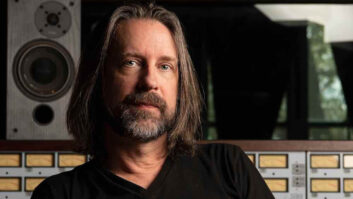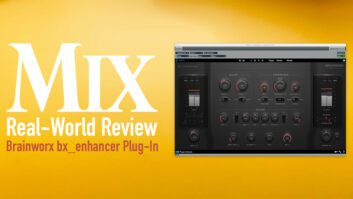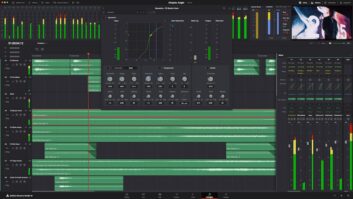Sometimes we each have an opportunity to participate in the proverbial “once in a lifetime” endeavor. For me, a grand adventure to Canyonlands that I enjoyed with a bunch of friends immediately comes to mind. But more to the point, this column affords another unique opportunity to exercise my foggy pre-vision as this is the last edition of “Bitstream” for the 20th century. I know, some of you think there are 99 years in a century, but I are an engineer and can count real good.
The coming 10 score years will be impacted most, I believe, by our understanding of biological processes rather than electronic ones. Ownership of intellectual property of biological advances is something I plan to follow closely. Anyway, I’ll try to keep the sweeping predictions, such as matter transporters and a cure for cancer, out of the picture, while concentrating on forces affecting our biz. The most prominent is electronics, where revolutionary, fundamental improvements will slow. Innovation will continue, but only if corporations continue to invest in basic research.
A brief example about investing in patient inquiry illustrates my point. The folks at IBM’s Almaden Research Center recently announced that they found that they can quadruple the storage capacity of magnetic coatings on their disk products, not through ever smaller heads and more sophisticated channel processing, but with applied materials science. Their “Pixie Dust” process, a coating of ruthenium, only a few atoms thick, dramatically improves magnetization density while reducing self-erasure. Basic research and long hours will yield most of the changes in store for us.
The integration of electronics and photonics will evolve to the point where, for an end-user, significant differentiation between either technology will be moot. This will, in turn, affect how we interact with, and our perception of, all things tech. The biggest impact will be in networking and computing. More on computers in a bit.
Networks: invisible, ubiquitous and fast enough for everything save time travel. Communication with each other and access to pertinent information will be immediate and effortless, though it still will not come cheap. It will take more than 100 years for us to wean ourselves from 20th-century ideologies.
The obvious changes will be in the areas of integration and interface. If voice- and visual-pattern recognition and synthesis advance along with heuristics, then machines, whether car or console, would operate with a level of autonomy presently unknown. This brings new meaning to the word “assistant.” Our current notion of a robot is more akin to that of the concept’s founder in the ’20s than what researchers will produce 80 years from now. Besides, a machine needn’t be anthropomorphic to assist in daily tasks, especially when we’re bored or distracted. Think of the tedium of QC’ing copies. Several groups are working on repeatable mechanisms to meaningfully measure what has been considered “subjective” phenomenon, like audible and visual impairments resulting from lossy encoding — wish I had such a beast back in my dHouse days!
On other fronts, significant progress will be made in the acquisition and storage of power, a particularly sticky wicket for those working on “ubicomp,” or ubiquitous computing. In truth, technological change comes from the results of hard work and serendipity, though I haven’t a clue as to their ratio. A lucky coincidence revealed the wisdom of using room-temperature ionic liquids for advanced battery applications, whereas 150 years of dogged research is slowly yielding energy storage secrets of another kind. There’s still a lot to be learned about batteries, but fuel cells are the energy darlings of the next decade. (Fuel cells are devices that generate electricity and heat by oxidizing or “burning” some sort of fuel.) Fuel examples are methane, hydrogen or gasoline, all derived primarily from nonrenewable resources, and ethanol, a more responsible alternative. The folks at Motorola, the company at the heart of DAWs and cell phones alike, have shown a prototype fuel cell, about two cubic inches in size, that provides 100 mW of continuous power when fed with ethanol. “Wait a minute, Jimmy, gotta give my cell phone a nip…”
Moto has also been slogging along in other areas. One in particular is relevant to my mention of the melding of photonics and electronics. They have finally been able to fabricate silicon and so-called III-V structures on the same substrate. III-V semiconductor materials include gallium arsenide, indium phosphide and other compounds that form the heart of both ultra-performance CPUs and light-emitting devices like LEDs. This work opens the door to high-performance, solid-state devices that will store, manipulate, modulate and transport data on light carriers, which makes the current crop of computers and storage look anemic in comparison. Sugar cube-sized “data cubes” with terabyte capacity along with a MiniDisc-sized recorder isn’t a far-fetched idea, given present day research. Think of the multichannel mixes you could carry on that!
On to our current, “advanced” distribution formats. Audio tools will mature to the point where reproduction of an acoustic event will be indistinguishable from having been there in the flesh. The visual component will still lag behind, though only a slight suspension of disbelief will be required, as opposed to the deliberate shift in mood and perceptual state that is required today. With storage capacity no longer a factor in the equation, double- and quad-speed DSD becomes less mind-boggling for those stuck in the 48/24 paradigm. Cheap, fat parallel processors and memory mean that personal HRTFs, along with convincing 3-D audio, are not too far away.
Before you take too much of my opinion to heart, I’d like to provide a bit of perspective and give a brief look at what other thinkers have said about the future of technology. As you know, much of the world will be lolling about the evening of what I call December 31, 2001, because, in their view, it ain’t all that special. By some folks’ reckoning, we’ll be passing through the year 5762, and by others it’s 1422. As to deep thought about the future, here are a few that I’m sure you’ve seen, but are worth repeating nonetheless…
“I think there is a world market for about five computers.” So said Thomas Watson, chairman of IBM, in 1943. Popular Mechanics, forecasting the development of computer technology in 1949, posited that “computers in the future may…perhaps only weigh 1.5 tons.” Made sense at the time. June 14, 2001, was the 50th anniversary of Univac, the first commercial, electronic digital computer. Just like other disciplines well known to you, computers started life in the 1820s as mechanical contrivances, evolved into purely electronic devices operating in the analog domain, and only 50 years ago, adopted the binary approach we take for granted today. “There is no reason for any individual to have a computer in their home,” said Kenneth Olsen, then president and founder of Digital Equipment Corporation in 1977. Now that’s what I call shortsighted! By 1977, Ed Roberts had made a name for himself from the sale of his Altair 8800, the first successful, mass-market personal computer, and Apple, Commodore and Tandy were in the ascendant.
In closing, think back to the recent 20th anniversary of music television. Ah, yes, I remember watching that Buggles video. MTV rapidly moved from an exciting outlet for innovative pop to a bland, self-serving product that defines corporate-media programming. Whatever the future holds, I hope widespread data connectivity brings the content diversity that marked early radio and television. But more importantly, connectedness engenders communication, and communication breeds understanding of other people’s cultures and self-image, world views and values. Lord knows we could use a lot more of that…Have a Happy New Year!
OMas is, at times, a senior consultant for Data Storage Technologies Inc., and during his day, marvels at the herd instinct of the pro audio community. For links, back issues and occasional commentary, check outhttp://seneschal.net.
PEDANT IN A BOX
The buzz phrase for this month is…HRTF. HRTFs, or Head-Related Transfer Functions, are mathematical models of the sound pressure that an arbitrary sound source produces at an eardrum, either real or synthetic. Microphones, along with a mannequin or “dummy head,” make acceptable substitutes for the organic variety, but the real challenge comes in figuring out the effects of the pinne, those elaborate convolutions of our outer ear. A monaural sound, when reproduced via two transducers and passed through an HRTF, can provide varying degrees of “3-D” or phantom placement, also know as pseudostereophony.
Speaking of convolutions, the outer ear, along with our head and torso, acts as an acoustic filter, “convolving the data” that reaches our eardrums. Because each person’s shape is different and each brain has adapted to that individuality, it’s very difficult to create a single HRTF that produces convincing 3-D audio for a large sampling of people.
— OMas







